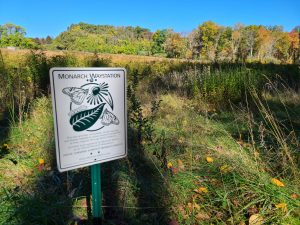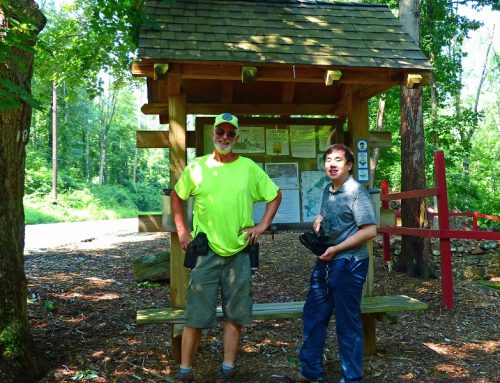 Distinctive orange and black Monarch butterflies that flutter from flower to flower each summer consistently delight those who are fortunate enough to watch them. However, they have been on the decline for several decades, largely due to habitat destruction and overuse of pesticides. This trend has prompted a nationwide effort to restore habitat that will help boost populations. A nationwide effort to reintroduce this butterfly’s host plant, the common milkweed, has been the focus of the work of the nonprofit group Monarch Watch based out of the University of Kansas.
Distinctive orange and black Monarch butterflies that flutter from flower to flower each summer consistently delight those who are fortunate enough to watch them. However, they have been on the decline for several decades, largely due to habitat destruction and overuse of pesticides. This trend has prompted a nationwide effort to restore habitat that will help boost populations. A nationwide effort to reintroduce this butterfly’s host plant, the common milkweed, has been the focus of the work of the nonprofit group Monarch Watch based out of the University of Kansas.
Monarch Watch provides guidance to state and local governments as well as landowners on how to establish a monarch garden using milkweed and other nectar plants. They advise, “To offset the loss of milkweeds and nectar sources we need to create, conserve, and protect monarch butterfly habitats. You can help by creating “Monarch Waystations” (monarch habitats) in home gardens, at schools, businesses, parks, zoos, nature centers, along roadsides, and on other unused plots of land. Creating a Monarch Waystation can be as simple as adding milkweeds and nectar sources to existing gardens or maintaining natural habitats with milkweeds.”
Here in Chester at Highlands Ridge Park, there are several acres of established wildflower meadow adjacent to the Chester Community Garden. This fall, the Chester Environmental Commission took steps to designate this area as an official ‘Monarch Waystation.’ They joined the University of Kansas program as the property met the qualifications of a mix of native wildflowers providing nectar, and various varieties of milkweed, on which monarch caterpillars feed and adults lay their eggs.
Chester Township is proud to support the Monarch Butterfly population by participating in this nationwide program. The monarch meadow at Highlands Ridge park is visible to anyone hiking along the trails in the property around the Chester Community Garden. “We hope that residents and other visitors will enjoy walking throughout the park and viewing milkweed and other wildflowers, and see monarch butterflies in summer and early fall before they begin their journey south to Mexico,” says Environmental Commission Chairman Steve Hansbury. “We hope that many residents will be inspired to create monarch habitat in their own yards at home and contribute to the effort to restore necessary habitat for the monarch butterfly species’ survival.”
Monarch Watch writes, “Monarch Waystations are places that provide resources necessary for monarchs to produce successive generations and sustain their migration. Without milkweeds throughout their spring and summer breeding areas in North America, monarchs would not be able to produce the successive generations that culminate in the migration each fall. Similarly, without nectar from flowers these fall migratory monarch butterflies would be unable to make their long journey to overwintering grounds in Mexico. The need for host plants for larvae and energy sources for adults applies to all monarch and butterfly populations around the world.”
During the monarch butterfly’s life cycle, adult females lay fertile eggs on milkweed, and the larvae hatch and feed on the milkweed leaves. The caterpillars grow quite big, almost to two inches, and then curl into a j-shaped chrysalid and hang on the plant. Over the course of the next 1-2 weeks, the caterpillar body liquifies and rearranges itself in a remarkable metamorphosis. The chrysalid changes from an opaque green to translucent as an orange and black butterfly forms inside. When ready, the butterfly hatches out, dries its wings and takes flight. Some of these newly hatched butterflies will repeat the life cycle. But others will begin a lengthy migration all the way to Mexico where they will spend the winter, and make the return flight in spring to begin the life cycle anew. This process is so fascinating to observe, that thousands of citizen scientists have taken to rearing these creatures from eggs to adults, and celebrate the adults’ flight each summer. They share tips and successes through social media groups.
Anyone wanting to learn more about how they can help the monarch butterfly population can visit: monarchwatch.org


